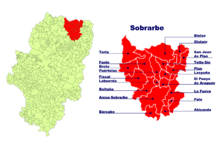Boltaña
| Boltaña municipality | ||
|---|---|---|
| coat of arms | Map of Spain | |

|
|
|
| Basic data | ||
| Autonomous Community : | Aragon | |
| Province : | Huesca | |
| Comarca : | Sobrarbe | |
| Coordinates | 42 ° 24 ' N , 0 ° 1' E | |
| Height : | 643 msnm | |
| Area : | 139.5 km² | |
| Residents : | 1,016 (Jan 1, 2019) | |
| Population density : | 7.28 inhabitants / km² | |
| Postal code : | 22340 | |
| Municipality number ( INE ): | 22066 | |
| administration | ||
| Mayor : | María José Gistain (PSOE) | |
| Location of the municipality | ||

|
||
Boltaña ( Aragonese Boltanya ) is a municipality in the north of the Spanish province of Huesca in the Aragon region . Together with the municipality of Aínsa-Sobrarbe it is the administrative and judicial seat of the Comarca Sobrarbe , with Aínsa-Sobrarbe being its economic center. Boltaña currently (January 1, 2019) has 1016 inhabitants on an area of 139.5 km².
geography
The place is located at an altitude of 643 m on the lower reaches of the Ara River in the Zerbillonar Valley of the Aragonese Pre-Pyrenees, a few kilometers downstream (and thus southwest) of Fiscal and the upper Broto Valley of the Ara. It is located at the foot of Mount San Martín , on which are the ruins of a fortress originally built by the Arabs before the 10th century, the castle of Boltaña , which is also erroneously called "Castle of the Counts of Sobrarbe", although it was never called The seat of the Christian county Sobrarbe was used.
To the left of the river is the Cañimás Gorge, on one side of which lies San Vicente de Labuerda, the second most important place in the municipality of Labuerda , and on the other, Moriello de Sampietro , an abandoned village at the end of the Bio Valley that belongs to Boltaña.
history
The place was the capital of the so-called Boletania , which already existed at the time of the Roman conquest of the Iberian Peninsula. The Romans called the place Municipium Boletanum ; at that time it was the main town along the Ara. The castle of Boltaña was built here after the Arab conquest and formed an important defensive position on the border with the Spanish Mark . It is reported that Caliph Abd al-Rahman III. appointed an Amrus ibn Muhammad governor of the fortress in the early 10th century. It is not known exactly when Christian rulers conquered Boltaña, but García III counted . Sánchez of Pamplona 941 possessions in the county of Sobrarbe to his dominion. In the 11th century Boltaña was ruled under the rule of Sancho Garcés ' by his nephew Gimeno Garcés (1028-1031) and then under Ramiro I and Sancho I of Aragon by Sancho Galíndez (1036-1080). During this period, the fortress and settlement of Boltaña were important bases of the Reconquista .
In the 12th century, Boltaña lost increasing importance in favor of neighboring Aínsa, especially after Alfonso I granted Aínsa special rights ( Fuero ) in a Carta Puebla in 1124 . In the following centuries, the importance of Boltañas decreased more and more until it became legally a place ruled from Aínsa without special privileges.
In 1430, when a certain Juan de Bardají held the title of Lord of Boltaña, King Alfonso V revoked the special rights ( Fueros ) of the place and returned them to the Crown of Aragon . In August 1456, Boltaña was given back the right to a mayor.
Architectural monuments
- The Roman Catholic parish church, consecrated to the Apostle Peter, dates from the 13th century and is Gothic in style .
- The main square, the Plaza de España , is characterized by arcades and Oberaragonien typical patios from.
- Finally, the ruins of Boltaña Castle consist of wall remains and the lower part of an octagonal tower. Legend has it that witch dances take place in the castle like on the Brocken .
Web links
Individual evidence
- ↑ Cifras oficiales de población resultantes de la revisión del Padrón municipal a 1 de enero . Population statistics from the Instituto Nacional de Estadística (population update).



